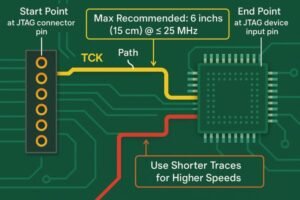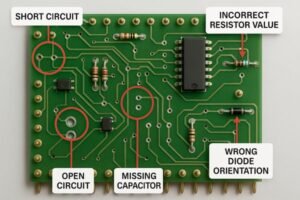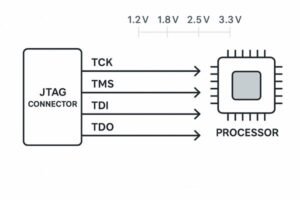Struggling with solderability for tiny BGAs? A poor surface finish can cause major headaches, leading to board failures and project delays. It's a common frustration I've seen many times.
For fine-pitch components like BGAs, Electroless Nickel Immersion Gold (ENIG) is generally your best bet. It offers a very flat surface, good solderability, and a decent shelf life. This helps ensure reliable connections, which are critical for today's high-density designs.

Choosing the right PCB surface finish isn't just a minor detail; it's a critical decision that impacts solderability, reliability, and even cost. Especially when you're dealing with modern electronics where components are shrinking and board density is increasing, the surface you solder to matters a lot. I've learned this lesson the hard way over my years in hardware design, from complex aerospace systems to compact medical devices. Let's dive deeper into how you can pick the perfect finish for your next project.
How Do I Choose the Right PCB Surface Finish for My Specific Application?
Overwhelmed by surface finish choices? I get it. Picking the wrong one can lead to frustrating assembly issues and even worse, field failures down the line. You want to avoid that.
To choose the right PCB surface finish, you need to consider several key factors. Think about your component types (especially if you have fine-pitch parts like BGAs), the expected shelf life of your boards, how many reflow cycles they'll go through, your budget, and any compliance requirements like RoHS.
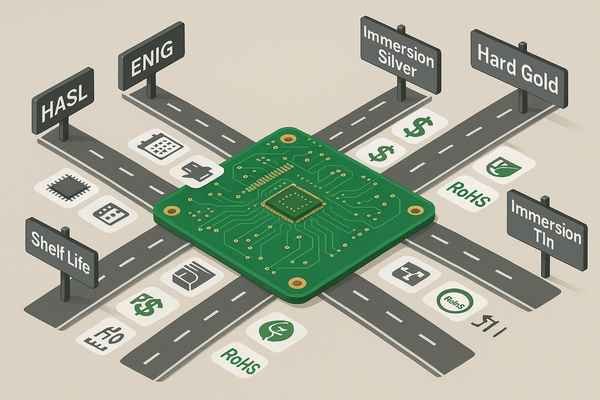
Selecting the right surface finish requires a balanced look at your project's specific needs. It’s not always about picking the most expensive or the cheapest option. During my time at Honeywell, working on the Tuxedo Keypad, we had to be very careful with our choices. The product had multiple SKUs for different markets, involving fine-pitch components and varied environmental conditions. Here’s a breakdown of what I consider:
Component Type and Density
If you're using fine-pitch components, especially Ball Grid Arrays (BGAs) or Quad Flat Packages (QFPs) with a pitch less than 0.5mm, you absolutely need a flat surface. This is non-negotiable for consistent solder paste deposition and accurate component placement. Finishes like ENIG1 or ENEPIG (Electroless Nickel Electroless Palladium Immersion Gold) provide this coplanarity. HASL (Hot Air Solder Leveling), on the other hand, tends to create an uneven surface, making it unsuitable for these tiny parts.
Soldering Process Requirements
Think about how many times the board will go through the reflow oven. Some finishes, like OSP2 (Organic Solderability Preservative), can degrade after multiple heat cycles. If your assembly process involves several reflows, you'll want something more robust like ENIG or even lead-free HASL.
Shelf Life and Storage
How long will your bare boards sit on a shelf before assembly? If it’s more than six months, a durable finish like ENIG is a safer bet than OSP, which can lose its solderability over time, especially if not stored perfectly. IPC-1601A, "Printed Board Handling and Storage Guidelines," offers good advice here.
Cost Considerations
Budget always plays a role. HASL is typically the most economical. OSP is also relatively inexpensive. ENIG and ENEPIG are premium finishes and will add to your bare board cost. I'll cover cost in more detail later.
Environmental Regulations
Most projects today require RoHS (Restriction of Hazardous Substances) compliance. This means lead-free finishes are a must. Lead-Free HASL, ENIG, ENEPIG, Immersion Silver (ImAg), and OSP all meet this requirement.
Specific Application Needs
Sometimes, the application dictates the finish. For example, if you need wire bonding capability, ENEPIG or ENIG with a sufficient gold thickness (typically >0.2 µm for gold wire bonding) are suitable. For press-fit connectors, you'll need a finish that can handle the insertion force, which I'll discuss separately.
Here’s a quick table to help summarize key application drivers:
| Feature | Impact on Application | Recommended Finishes |
|---|---|---|
| Fine Pitch (<0.5mm) | Requires an extremely flat surface for good solder paste printing and reliable component placement. | ENIG, ENEPIG, thin OSP |
| BGA/CSP Components | Needs excellent coplanarity to ensure all solder balls form reliable joints. | ENIG, ENEPIG |
| Multiple Reflow Cycles | The finish must withstand heat without degrading or forming excessive intermetallic compounds. | ENIG, ENEPIG, LF-HASL |
| Long Shelf Life (>6mo) | Needs robust protection against oxidation and contamination during storage periods. | ENIG, ENEPIG |
| Strict Cost Constraint | Budget limitations may necessitate choosing a more economical, yet suitable, option. | LF-HASL, OSP |
| RoHS Compliance | Must avoid lead and other specific restricted substances as per environmental regulations. | LF-HASL, ENIG, OSP, ImAg |
| Wire Bonding (Al or Au) | Requires a surface that allows for reliable ultrasonic or thermosonic wire bonding. | ENEPIG, ENIG (thicker gold) |
| Press-Fit Connectors | Needs a finish that won’t crack or flake under pressure and provides a stable electrical connection. | ImSn, ENIG |
Ultimately, understanding these factors helps you make an informed trade-off. There's rarely a single "perfect" finish for all situations.
How Do HASL, ENIG, and OSP Compare to Each Other?
Confused by all the acronyms like HASL, ENIG, and OSP? You're not alone. Choosing between them without understanding their core differences can unfortunately ruin an otherwise good board design.
In simple terms: HASL is low-cost and offers good solderability but results in an uneven surface. ENIG provides excellent surface flatness and good solderability, ideal for fine-pitch parts, but it's pricier. OSP is a cost-effective, flat finish, but it has a shorter shelf life and is sensitive to handling.

Let's break down these common finishes further. I've worked with all of them extensively, and each has its place.
Hot Air Solder Leveling (HASL / LF-HASL)3
- Process: The PCB is dipped into a bath of molten solder, and then high-pressure hot air knives blow off the excess, leaving a solder coating on the exposed copper pads. Lead-Free HASL uses a tin-silver-copper (SAC) alloy or similar.
- Pros: It's generally the lowest cost option, very robust, offers excellent solderability, and is quite tolerant to multiple rework cycles. It's been an industry workhorse for decades.
- Cons: The biggest drawback is the uneven surface topography it creates. This makes it generally unsuitable for fine-pitch components below 0.8mm pitch or small BGAs (e.g., <0.5mm pitch). The process also puts thermal stress on the board. The thickness can vary significantly, typically from 1 µm to 40 µm.
- My Take: I'd use HASL for simpler boards with larger pitch components where cost is a primary driver and absolute flatness isn't critical.
Electroless Nickel Immersion Gold (ENIG)
- Process: This is a two-layer metallic coating. First, an electroless nickel layer is plated onto the copper (typically 3-6 µm thick, as per IPC-4552B). Then, a thin layer of immersion gold (typically 0.05-0.1 µm for soldering applications, per IPC-4552B) is deposited over the nickel. The gold protects the nickel from oxidizing until soldering.
- Pros: ENIG provides a very flat (coplanar) surface, essential for fine-pitch components and BGAs. It has good solderability and a long shelf life, often 12 months or more. It's also suitable for aluminum wire bonding and as a contact surface.
- Cons: It's more expensive than HASL and OSP. There's a historical concern known as "black pad" (a potential brittle fracture at the nickel-solder interface due to excessive phosphorus or corrosion in the nickel), but modern chemical processes have largely mitigated this. The process itself is more complex.
- My Take: When I worked on the next-generation infusion pump at Smiths Medical, which involved intricate sensor modules and BGAs, ENIG was our go-to. The reliability and flatness it offered were crucial.
Organic Solderability Preservatives (OSP)
- Process: A very thin, transparent organic coating (typically 0.2-0.5 µm) is applied to the copper pads. This layer protects the copper from oxidation before soldering.
- Pros: OSP provides a very flat surface, is lead-free, and is generally more cost-effective than ENIG. The application process is also relatively simple and environmentally friendly.
- Cons: OSP has a limited shelf life, typically 6 to 12 months as per IPC-4554 (the standard often quotes 6 months, extendable to 12 with optimal packaging and conditions). It's sensitive to handling – oils from skin or scratches can damage the protective layer. It may not withstand multiple high-temperature reflow cycles well, as the OSP coating is consumed during each soldering process. Being transparent also makes visual inspection of the coating more challenging. It's not suitable for wire bonding or as a contact surface.
- My Take: OSP can be a good choice for high-volume, cost-sensitive consumer products with simpler assembly processes and where boards are assembled relatively quickly after fabrication.
Here's a comparative summary table:
| Feature | HASL (Lead-Free) | ENIG | OSP |
|---|---|---|---|
| Surface Flatness | Poor to Fair | Excellent | Excellent |
| Solderability | Excellent | Very Good | Good (can degrade with handling/time) |
| Fine Pitch Comp. | Not Recommended for <0.8mm pitch | Excellent | Good, but handling is critical |
| Shelf Life | 6-12 months | ≥12 months (IPC-4552B suggests min. 12 months) | 6-12 months (IPC-4554 suggests 6, up to 12 with ideal conditions) |
| Relative Cost | Low | High | Medium-Low |
| RoHS Compliant | Yes | Yes | Yes |
| Multiple Reflows | Good | Very Good | Fair (can degrade after 1-2 cycles) |
| Visual Inspection | Easy (metallic sheen) | Easy (gold color) | Difficult (transparent coating) |
| Wire Bondable | No | Yes (with adequate gold thickness) | No |
| Typical Thickness | Solder: 1-40 µm | Ni: 3-6 µm, Au: 0.05-0.1 µm (soldering) | Organic Layer: 0.2-0.5 µm |
Understanding these trade-offs is key to making a cost-effective and reliable choice.
Which Surface Finish Is Recommended for Press-Fit Connectors?
Are your press-fit connectors causing issues? The wrong PCB surface finish can definitely lead to connection problems, high insertion forces, or even damage to the plated through-holes (PTHs).
For press-fit connectors, Immersion Tin (ImSn)and ENIG are often the top recommendations. These finishes generally provide the necessary good electrical conductivity, some lubricity for insertion, and can withstand the mechanical stress without cracking or excessive wear on the PTH barrel.
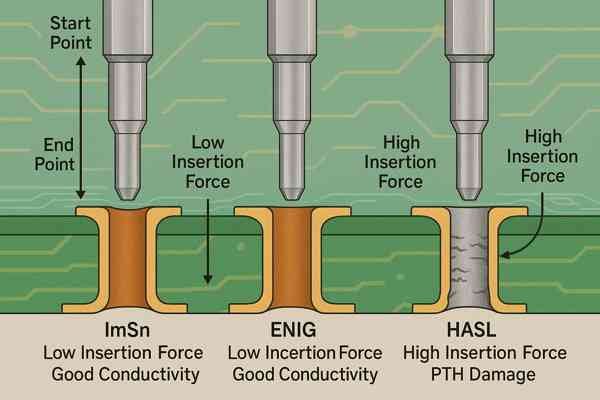
Press-fit technology is great because it creates a solder-free, gas-tight connection. But the integrity of that connection heavily relies on the PTH and its surface finish.
Key Requirements for Press-Fit Finishes
Here’s what I look for in a finish for press-fit applications:
- Good Electrical Conductivity: The connection needs to pass signals or power effectively.
- Lubricity and Malleability: The finish should allow the connector pin to be inserted without excessive force. A somewhat malleable finish helps.
- Resistance to Fretting Corrosion: A robust finish helps prevent corrosion from micro-movements.
- No Cracking or Flaking: The finish must adhere well and not be damaged during insertion.
- Consistent Thickness: Uniformity is important for consistent insertion force and contact.
Based on these needs, here’s how different finishes stack up:
Immersion Tin (ImSn)
ImSn is a common recommendation from many connector manufacturers.
- Pros: Offers excellent flatness and good initial solderability. It provides lubricity, beneficial for press-fit. Typical thickness is 0.8-1.2 µm (IPC-4553A).
- Cons: Potential for tin whisker growth and IMC formation. Shelf life is somewhat limited (3-6 months, though some newer processes claim longer).
- My Experience: I’ve seen ImSn specified by suppliers like TE Connectivity.
ENIG (Electroless Nickel Immersion Gold)
- Pros: The hard nickel underlayer (3-6 µm) withstands insertion forces. Thin gold (0.05-0.1 µm) gives corrosion resistance and good initial contact.
- Cons: More expensive than ImSn. Gold may wear, but the nickel underneath provides reliable contact.
- My Experience: Samtec often lists ENIG as compatible for their press-fit systems.
Hard Gold (Electrolytic Gold)
- Pros: Exceptionally durable, excellent for high wear or many mating cycles.
- Cons: Very expensive, usually applied selectively. Often overkill for typical press-fit (single insertion).
Finishes to Approach with Caution for Press-Fit
- HASL: Its uneven surface can lead to inconsistent contact pressure and may require higher, potentially damaging, insertion forces.
- OSP: Too thin and soft. It would likely be scraped off during insertion, exposing copper to oxidation and risking an unreliable connection.
The following table compares these finishes for press-fit suitability:
| Feature / Finish | Immersion Tin (ImSn) | ENIG | Hard Gold (Selective) | HASL | OSP |
|---|---|---|---|---|---|
| Lubricity | Good | Fair | Fair | Poor | Poor |
| Wear Resistance | Fair | Good (Nickel layer) | Excellent | Fair | Poor |
| Cracking/Flaking Risk | Low | Low | Very Low | Medium (unevenness) | High (scrapes off easily) |
| Conductivity | Good | Very Good | Excellent | Good | Good (if intact) |
| Relative Cost | Medium | High | Very High | Low | Low |
| Manufacturer Rec. | Often | Often | Specific High-Wear Apps | Rarely | Not Recommended |
| Surface Flatness | Excellent | Excellent | Excellent | Poor | Excellent |
Crucial Advice: Always, and I mean always, check the press-fit connector manufacturer's datasheet. They will specify the recommended PCB finishes and hole tolerances. Adhering to their guidelines is the best way to ensure a reliable press-fit connection. Also, IPC-A-6104 ("Acceptability of Electronic Assemblies") and IPC-6012 ("Qualification and Performance Specification for Rigid Printed Boards") provide criteria for assessing the integrity of PTHs after press-fit operations.
How Does the Choice of PCB Surface Finish Affect the Overall Cost of the Board?
Trying to keep your PCB costs down? I've been there on almost every project! The surface finish might seem like a small part, but its impact on the final board price can be quite significant.
Generally, HASL (Hot Air Solder Leveling) is the cheapest option, followed closely by OSP (Organic Solderability Preservative). Finishes like ENIG (Electroless Nickel Immersion Gold) and ENEPIG are considerably more expensive due to the use of precious metals and more complex processing steps. Immersion Silver and Immersion Tin usually fall in the middle.

The cost of a surface finish isn't just an arbitrary markup by the PCB fabricator. Several factors contribute to the final price you pay:
Material Costs
This is a big one. Gold (used in ENIG, ENEPIG, Hard Gold) and Palladium (in ENEPIG) are precious metals with fluctuating market prices. Their inclusion inherently drives up the cost. Tin, silver, and organic compounds are less expensive.
Process Complexity & Number of Steps
Finishes like ENIG and ENEPIG involve multiple chemical bath stages, each requiring precise control. More steps and tighter controls mean more labor, equipment time, and higher chances of yield loss if not managed perfectly. HASL is simpler by comparison. OSP is often the simplest chemical process.
Waste Treatment
Chemical baths, especially for metallic finishes like ENIG, generate waste products that require specialized and often costly treatment to comply with environmental regulations. These costs are factored into the finish price.
Yield Rates
More complex processes might inherently have slightly lower yields. This risk is often reflected in the pricing.
Relative Cost Comparison
Here’s a table showing rough relative costs, assuming Lead-Free HASL as a baseline (1x). Please remember these are general industry estimates and can vary:
| Surface Finish | Relative Cost Factor (LF-HASL = 1x) | Key Cost Drivers |
|---|---|---|
| Leaded HASL | ~0.9x | Simpler process, tin/lead alloy |
| OSP | ~0.8x - 1.1x | Simple organic chemistry, few steps |
| Lead-Free HASL | 1x (Baseline) | Higher temp solder, slightly more complex than leaded |
| Immersion Tin (ImSn) | ~1.2x - 1.5x | Tin metal, chemical process |
| Immersion Silver (ImAg) | ~1.2x - 1.6x | Silver metal, chemical process, anti-tarnish handling |
| ENIG | ~1.8x - 2.5x | Nickel & Gold (precious metal), complex multi-step process |
| ENEPIG | ~2.0x - 3.0x | Nickel, Palladium & Gold (precious metals), very complex |
| Hard Gold (Selective) | Significantly Higher (area dependent) | Gold (thicker layer), electrolytic process, masking |
Beyond Bare Board Cost – Total Cost of Ownership (TCO)
When I was a technical leader for the Tuxedo Keypad at Honeywell, we had to balance upfront board costs with assembly yields and long-term reliability. A slightly more expensive finish like ENIG might add 10-20% to the bare board cost compared to LF-HASL. For a $10 board, that's $1-$2 extra. However, if ENIG prevents even a small percentage of BGA soldering failures, which could cost $20-$50 each to rework or scrap, the TCO quickly favors the initially "more expensive" finish. Field failures are even more costly.
So, while LF-HASL or OSP might look attractive for their low upfront cost, if you're dealing with fine-pitch BGAs or require very high reliability, the investment in a finish like ENIG can often save you money in the long run.
What Is the Typical Shelf Life of Different PCB Surface Finishes?
Storing PCBs for a while before assembly? It's a common scenario. But an expired or degraded surface finish can lead to terrible soldering results and a pile of scrap boards. Nobody wants that.
Generally, ENIG (Electroless Nickel Immersion Gold) and ENEPIG offer the longest shelf life, typically 12 months or even more under proper storage. OSP (Organic Solderability Preservative) is shorter, around 6 to 12 months. HASL (Hot Air Solder Leveling) also generally lasts 6 to 12 months. Crucially, proper packaging and storage conditions are vital for all finish types.

Defining Shelf Life
The "shelf life" of a PCB surface finish refers to the maximum time a bare board can be stored under specified conditions and still be expected to solder reliably using standard assembly processes.
Factors Affecting Shelf Life
Several factors influence this:
- The Finish Itself: Some materials are inherently more resistant to oxidation and environmental degradation.
- Packaging: This is critical. Boards should be in vacuum-sealed Moisture Barrier Bags (MBBs) with desiccant and a humidity indicator card (per IPC-1601A).
- Storage Environment: Ideal conditions are controlled temperature (e.g., 20-25°C or 68-77°F) and low relative humidity (e.g., <50% RH), away from corrosive gases.
Typical Shelf Lives
Here’s a more detailed look at typical shelf lives, often guided by IPC standards and manufacturer advice:
- HASL / LF-HASL: Generally 6 to 12 months. Solder can oxidize over time.
- OSP: Typically 6 to 12 months. IPC-4554 often indicates a 6-month minimum, extendable to 12 with optimal conditions. Sensitive to handling.
- Immersion Tin (ImSn): Usually 3 to 6 months (some modern types up to 12 months). Concerns are IMC growth and tin whiskers (IPC-4553A).
- Immersion Silver (ImAg): Typically 6 to 12 months (IPC-4553A). Susceptible to tarnishing; anti-tarnish packaging is essential.
- ENIG: Usually 12 months or longer. Gold protects the nickel (IPC-4552B suggests min. 12 months).
- ENEPIG: Also typically 12 months or longer. Palladium enhances protection (IPC-4556 suggests min. 12 months).
This table summarizes shelf life information:
| Surface Finish | Typical Shelf Life5 (Months) | IPC Standard (Reference) | Key Considerations for Longevity |
|---|---|---|---|
| HASL / LF-HASL | 6-12 | IPC-1601A for handling | Solder can oxidize/tarnish over time. |
| OSP | 6-12 | IPC-4554 | Very sensitive to handling, environment; effectiveness reduces after reflows. |
| ImSn | 3-6 (up to 12 for some types) | IPC-4553A | IMC growth, potential tin whiskers; sensitive. |
| ImAg | 6-12 | IPC-4553A | Risk of tarnishing (sulfidation); requires anti-tarnish packaging. |
| ENIG | ≥12 | IPC-4552B | Gold layer protects nickel; generally very robust. |
| ENEPIG | ≥12 | IPC-4556 | Palladium adds another protective barrier; excellent stability. |
Importance of Proper Storage
No matter the finish, always insist on proper packaging from your PCB fabricator. Inspect packaging on arrival. If you open an MBB, use the boards quickly or reseal them promptly with fresh desiccant. If boards are near or past their shelf life, or if storage is suspect, perform solderability tests on a sample before full assembly. This saved me trouble a few times with long-stored prototypes.
Conclusion
In summary, choosing the best PCB surface finish, especially for demanding applications with fine-pitch components like BGAs, involves carefully balancing performance needs, cost implications, and process compatibility. It's about ensuring reliable and durable end products.
-
Explore this link to understand the benefits and applications of ENIG finish in PCB manufacturing, crucial for high-performance electronics. ↩
-
Learn about OSP's pros and cons to make informed decisions for your PCB finishes, especially regarding solderability and cost. ↩
-
Discover the benefits and drawbacks of HASL, a popular choice for cost-sensitive PCB applications. ↩
-
Learn about IPC-A-610 standards to ensure the quality and reliability of your electronic assemblies, crucial for successful press-fit operations. ↩
-
Understanding shelf life helps in planning production and ensuring quality in PCB manufacturing. ↩



